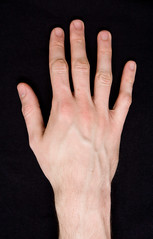
As someone who types for a living, I’ve always kept in the back of my mind that I didn’t want to lose the use of those appendages. Back in college, before I really started thinking about this, I noticed some of the early signs of carpal tunnel and, after stopping by the campus health center, they did also confirm that I was seeing those types of symptoms.
After doing a bit of research on the matter, I then bought a Kinesis keyboard (video example) and, since then, I haven’t had any problems; I could type all day and my wrists felt as good at the end of the day as they did at the beginning.
Over about the past week, though, I’ve noticed a bit of an ache at the base of my pinkie finger in my mousing hand, right around that finger’s knuckle area. (I’ve also added a Note to that Flickr image outlining the general area.) At first, I wondered a bit if I had broken it, but after thinking about it, I realized that the ache was coming and going—which I presume wouldn’t happen if it had actually been broken.
I wasn’t quite sure how I’d describe the ache/pain, but I’ll give it a shot. It doesn’t hurt enough that it stops me from sleeping. And, if I’m watching tv or otherwise pleasantly distracted, I can usually ignore it. Every now and then, the pain does occasionally reach to the level where I have to let go of my mouse for a minute and let my hand rest. Or, to put it another way, if you’ve ever punched a wall or otherwise slammed your knuckle into a hard surface (by accident or otherwise), it kinda feels like that sort of pain.
So, what now? Well, if I have any say in the matter, I still plan on typing for the rest of my professional career. And one might think, “Well, let's just add some ergonomics in there.” All of that makes sense, I think, but what I'm finding to me the tough part is separating the ergonomic myths from the legitimate guidelines. Let’s take a wrist rest, for example—I honestly don’t know if that would help or hinder. On top of that, I’m not entirely certain how I would figure that out.
For instance, this page at OSHA.gov suggests:
“Use a wrist rest to maintain straight wrist postures and to minimize contact stress during typing and mousing tasks.”
On the other hand, this page from the “Cornell University Ergonomics Web” says:
“Don’t use a Wrist Rest — research has shown that using a wrist rest doubles the pressure inside the carpal tunnel, because the floor of the tunnel is a more flexible ligament that transmits external pressure changes directly into the carpal tunnel (the roof of the tunnel is bone so the pressure doesn’t get transmitted on through the hand). […] ”
Now, I’d usually be more inclined to believe something if it’s posted at a .gov address (especially osha.gov, at that), but this case, it does seem that the Cornell page cites more evidence for its case. Come to think of it, after reading over that Cornell University Ergonomics Web page a bit more, it does appear that they know what they're talking about. I mean, when the footer of your page includes a link for “More information on our Mouse research studies”, that seems like a pretty good sign, no?
One way or another, I’ll need to take care of this. If you have any suggestions—even if they’re suggestions on how to tell the good ergonomics info from the old wives’ tales—I’d be open to them.